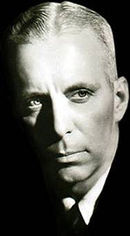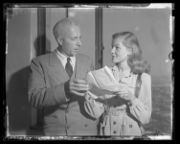Howard Hawks
| Howard Hawks | |
|---|---|
 |
|
| Born | Howard Winchester Hawks May 30, 1896 Goshen, Indiana, U.S. |
| Died | December 26, 1977 (aged 81) Palm Springs, California, U.S. |
| Occupation | Director, Producer, Screenwriter |
| Years active | 1923 - 1970 |
| Spouse | Athole Shearer (1928-1940) Slim Keith (1941-1949) Dee Hartford (1953-1959) |
Howard Winchester Hawks (May 30, 1896 – December 26, 1977) was an American film director, producer and screenwriter of the classic Hollywood era. He is popular for his films from a wide range of genres such as Scarface (1932), Bringing Up Baby (1938), Only Angels Have Wings (1939), His Girl Friday (1940), Sergeant York (1941), The Big Sleep (1946), Red River (1948), Gentlemen Prefer Blondes (1953), Rio Bravo (1959), and El Dorado (1967).
In 1975, Hawks was awarded the Honorary Academy Award as "a master American filmmaker whose creative efforts hold a distinguished place in world cinema,"[1] and in 1942 he was nominated for the Academy Award for Best Director for Sergeant York.
Contents |
Early life
Born in Goshen, Indiana, Hawks was the first-born child of Frank W. Hawks and the former Helen Howard. After the birth of his brother, Kenneth Neil Hawks, on August 12, 1899, the family moved to Neenah, Wisconsin. Shortly afterward they moved again, to Southern California.
Hawks attended high school in Glendora, and then moved to New Hampshire to attend Phillips Exeter Academy from 1912-1914. After graduation, Hawks moved on to Cornell University in Ithaca, New York, where he majored in mechanical engineering. During the summers of 1916 and 1917, Hawks worked on some early movies, interning for the Famous Players-Lasky Studio. After graduation he joined the United States Army Air Service after World War I. After the service, he worked at a number of jobs: race-car driver, aviator, designer in an aircraft factory.
Film career
By 1924 he had returned to Hollywood and entered the movie industry. He chummed with barn stormers and pioneer aviators at Rogers Airport in Los Angeles, getting to know men like Moye Stephens. Hawks wrote his first screenplay, Tiger Love (1924), was editor for some Paramount films such as Heritage of the Desert (1924), and directed his first film, The Road to Glory (1925). Hawks reworked the scripts of most of films he directed without taking official credit for his work. Howard Hawks directed a total of eight silent films, including Fazil in 1928.
He made the transition to sound without difficulty. During the 1930s he freelanced and was not contracted to a studio. For Howard Hughes he directed Scarface (1932); for RKO, Bringing Up Baby (1938) and for Columbia, Only Angels Have Wings (1939) and His Girl Friday (1940).
His film, Sergeant York (1941), starring Gary Cooper, was the highest-grossing film of its year and won two Academy Awards (Best Actor and Best Editing).
In 1944, Hawks filmed the first of two films starring Humphrey Bogart and Lauren Bacall, To Have and Have Not, which was the first film pairing of the couple. He followed that with The Big Sleep (1946).
In 1948, he filmed Red River, with John Wayne and Montgomery Clift. In 1951, he produced - and, reputedly, also directed (without credit) - The Thing from Another World.[2] In 1953, he filmed Gentlemen Prefer Blondes, which featured Marilyn Monroe singing "Diamonds Are a Girl's Best Friend."
1959's Rio Bravo, starring John Wayne, Dean Martin and Walter Brennan, was remade twice by Hawks - in 1967 (El Dorado) and again in 1970 (Rio Lobo). Both starred John Wayne.
Personal life

Hawks was married three times:
- to Athole Shearer (1928–1940), sister of movie actress Norma Shearer, mother of his daughter Barbara Hawks and son David Hawks;
- to Slim Keith (1941–1949), who was the mother of his daughter, Kitty Hawks, a noted interior designer; and
- to Dee Hartford (1953–1959), an actress whose real name was Donna Higgins.
His brothers were director/writer Kenneth Neil Hawks and film producer William Bettingger Hawks.
Style
Hawks was versatile as a director, filming comedies, dramas, gangster films, science fiction, film noir, and Westerns. Hawks's own functional definition of what constitutes a "good movie" is revealing of his no-nonsense style: "Three great scenes, no bad ones."[3][4] Hawks also defined a good director as "someone who doesn't annoy you".[4]
While Hawks was not sympathetic to feminism, he popularized the Hawksian woman archetype, which could be considered a prototype of the modern post-feminist movement.
Legacy
His directorial style and the use of natural, conversational dialogue in his films were cited a major influence on many noted filmmakers, including Robert Altman, John Carpenter, and Quentin Tarantino.
Although his work was not initially taken seriously by British critics of the Sight and Sound circle, he was venerated by French critics associated with Cahiers du cinéma, who intellectualised his work in a way Hawks himself was moderately amused by, and he was also admired by more independent British writers such as Robin Wood and, to a lesser extent, Raymond Durgnat.
Critic Leonard Maltin labeled Hawks "the greatest American director who is not a household name," noting that, while his work may not be as well known as Ford, Welles, or DeMille, he is no less a talented filmmaker.
Awards
He was nominated for Academy Award for Best Director in 1942 for Sergeant York, but he received his only Oscar in 1975 as an Honorary Award from the Academy.
Scarface (1932), was rated "culturally significant" by the United States Library of Congress.
Bringing up Baby (1938) was listed number ninety-seven on American Film Institute's AFI's 100 Years... 100 Movies. His Girl Friday (1940) was listed #19 on American Film Institute's AFI's 100 Years... 100 Laughs.
For his contribution to the motion picture industry, Howard Hawks has a star on the Hollywood Walk of Fame at 1708 Vine Street.
Filmography
References
- ↑ IMDB awards
- ↑ "And let's get the record straight. The movie was directed by Howard Hawks. Verifiably directed by Howard Hawks. He let his editor, Christian Nyby, take credit. But the kind of feeling between the male characters—the camaderie, the group of men that has to fight off the evil—it's all pure Hawksian." Carpenter, John (speaker). (2001-09-04). Hidden Values: The Movies of the '50s. [Television production]. Turner Classic Movies. http://www.tcm.com/thismonth/article.jsp?cid=88193&mainArticleId=218757. Retrieved 2009-04-01.
- ↑ Chicago: item notes v.24 1975 July-December, WFMT (Radio station : Chicago, Ill.), 1975, http://books.google.com/books?ei=93-YSY29GIvCMrnv7KQJ&q=howard+hawks+three+good+scenes+and+no+bad+ones
- ↑ 4.0 4.1 Howard Hawks; Scott Breivold (2006), Howard Hawks, Univ. Press of Mississippi, p. 63, ISBN 9781578068333, http://books.google.com/?id=LQ6cn-dhUzIC&pg=PA63&dq=%22great%20scene%22
Further reading
- Clark Branson, Howard Hawks, A Jungian Study, Garland-Clarke Editions, 1987
- Jim Hillier, Howard Hawks: American Artist, Peter Wollen (British Film Institute, 1997)
- Suzanne Liandrat-Guigues, Red River, bfi Publishing, 2000
- Joseph McBride, Hawks on Hawks, (University of California Press, 1982)
- Joseph McBride (ed), Focus on Howard Hawks, Prentice-Hall, Inc, 1972
- Todd MacCarthy, Hawks: The Grey Fox of Hollywood, (Grove Press, 1997)
- Pippin, Robert B. Hollywood Westerns and American Myth: The Importance of Howard Hawks and John Ford for Political Philosophy (Yale University Press, 2010) 208 pp.
- Robin Wood, Howard Hawks, Secker & Warburg, 1968
- Robin Wood, Howard Hawks, British Film Institute, 1981, revised with addition of chapter "Retrospect".
- Robin Wood,Rio Bravo, bfi Publishing, 2003
- Robin Wood, Howard Hawks (New Edition), (Wayne State University Press, 2006)
External links
- Howard Hawks at the Internet Movie Database
- Howard Hawks at the TCM Movie Database
- Bibliography of books and articles about Hawks via UC Berkeley Media Resources Center
- Senses of Cinema profile
- Howard Hawks at Find a Grave
|
||||||||||||||||||||